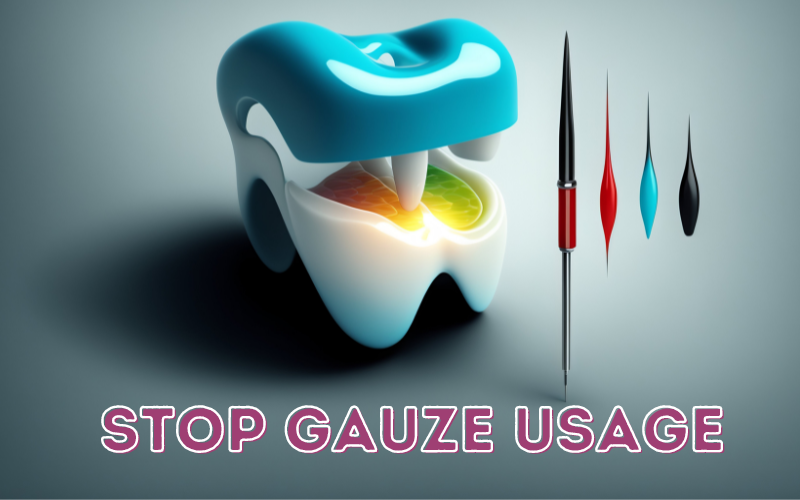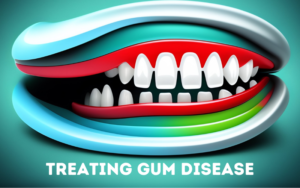
Knowing When to Stop Gauze Usage After Tooth Extraction
Tooth extraction is a common dental procedure that may be necessary due to various reasons using gauze such as severe tooth decay, infection, overcrowding, or trauma.
After the extraction, the dentist or oral surgeon typically places a gauze pad over the extraction site to control bleeding and promote healing.
However, many patients are unsure about when it is appropriate to stop using gauze and how to properly care for the extraction site. In this comprehensive guide, we will address these concerns and provide helpful information regarding gauze usage after tooth extraction.
When to Stop Using Gauze After Wisdom Tooth Extraction:
Wisdom tooth extraction can be more complex than regular tooth extraction due to the location and size of the wisdom teeth. The duration of gauze usage may vary depending on the complexity of the extraction.
It is generally recommended to use gauze for at least 30 minutes to an hour after the procedure to allow blood clot formation. However, the specific duration may be advised by your dentist based on individual circumstances.
As a general guideline, you can usually stop using gauze when the bleeding has significantly reduced or stopped altogether.
Should I Sleep with Gauze After Tooth Extraction:

Sleeping with gauze after tooth extraction is not necessary unless bleeding is still active. It is important to allow the blood clot to form and protect the extraction site during sleep.
If bleeding has stopped or is minimal, it is generally safe to remove the gauze before going to bed. However, it is essential to follow your dentist’s instructions, as they may provide specific guidance based on the complexity of the extraction and individual healing progress.
When Can I Spit After Tooth Extraction:
After tooth extraction, it is advisable to avoid spitting forcefully for the first 24 hours. Forceful spitting can dislodge the blood clot, leading to a condition called dry socket, which can be painful and delay the healing process.
Instead of spitting, gently let saliva drool out of your mouth or use a disposable cup to spit without creating suction. After 24 hours, you can generally resume normal spitting, but it is always best to consult your dentist for personalized instructions.
The First Night After Tooth Extraction:
The first night after tooth extraction requires some special care to ensure optimal healing. Here are a few tips to make it more comfortable:
Keep your head elevated while sleeping to minimize swelling.
Avoid sleeping on the side of the extraction site to prevent undue pressure.
Take any prescribed pain medications as directed by your dentist.
Avoid touching the extraction site with your tongue or fingers.
Do I Eat with Gauze in Mouth After Extraction:
No, you should not eat with gauze in your mouth after tooth extraction. Gauze is primarily used to control bleeding immediately after the procedure.
Eating with gauze in your mouth can dislodge the blood clot and cause bleeding filter to resume. Wait until the bleeding has significantly reduced or stopped before attempting to eat. Once you are ready to eat, choose soft, cool, and nutritious foods that do not require excessive chewing.
Ran Out of Gauze for Tooth Extraction:
If you run out of gauze after tooth extraction, there are alternative options you can consider. One option is to use a dampened tea bag, preferably black tea, as it contains tannins that can help promote blood clotting and reduce bleeding.
Place the damp tea bag over the extraction site and bite down gently for about 30 minutes. Another alternative is to use sterile gauze or a clean cotton cloth as a temporary substitute until you can obtain more from your dentist or local pharmacy.
How to Fold Gauze for Tooth Extraction:
Properly folding gauze for tooth extraction can ensure better absorption and coverage of the extraction site. Here’s a simple method to fold gauze:
Start with a sterile gauze pad or cotton roll.
Fold the gauze pad into a square by bringing the corners together.
Fold the square diagonally to create a triangle.
For better coverage, you can fold the triangle in half again, creating a smaller triangle.
Remember to follow any specific instructions provided by your dentist regarding gauze folding or use any pre-folded gauze provided.
Can I Eat if My Tooth Extraction Is Still Bleeding:

If your tooth extraction site is still actively bleeding, it is best to avoid eating until the bleeding has significantly reduced or stopped. Eating can disrupt the blood clot formation and lead to prolonged bleeding.
Instead, focus on staying hydrated by drinking cool liquids, preferably with a straw placed away from the extraction site. If bleeding persists or is excessive, contact your dentist for further guidance.
FAQs (Frequently Asked Questions):
Q1: How long should I keep the gauze in my mouth after tooth extraction?
A: It is generally recommended to keep the gauze in your mouth for at least 30 minutes to an hour after the tooth extraction. This allows enough time for a blood clot to form and helps control bleeding.
However, follow the specific instructions provided by your dentist. As the duration may vary based on the complexity of the extraction.
Q2: Can I change the gauze pad during the healing process?
A: If the bleeding has significantly reduced or stopped, there is usually no need to continue using gauze pads. Changing the gauze pad is typically unnecessary unless bleeding persists or your dentist advises you otherwise.
However, if the gauze becomes saturated with blood before the recommended time, you can gently remove it and replace it with a fresh gauze pad.
Q3: What should I do if the extraction site continues to bleed even after using gauze?
A: If the bleeding from the extraction site persists or is excessive, it is important to contact your dentist for further guidance. They may provide specific instructions or request a follow-up appointment to evaluate the situation.
In the meantime, you can apply firm pressure to the extraction site using a clean gauze pad or a dampened tea bag to help promote clotting.
Q4: Is it normal to experience some bleeding after tooth extraction?
A: It is normal to experience some bleeding after tooth extraction. However, the amount of bleeding should decrease over time.
If the bleeding continues or becomes heavy, it is advisable to contact your dentist. Remember to follow their instructions regarding gauze usage, and avoid activities that may increase blood flow, such as vigorous rinsing or spitting.
Q5: When can I start eating solid foods after tooth extraction?
A: It is recommended to stick to a soft or liquid diet for the first 24-48 hours after tooth extraction to allow the extraction site to heal. After this initial period, you can gradually introduce soft, chewable foods into your diet.
Avoid hard, crunchy, or sticky foods that may irritate or dislodge the blood clot. It is always best to consult your dentist for specific dietary recommendations based on your individual case.
Q6: Can I use gauze to stop bleeding from the extraction site if I ran out of gauze pads?
A: If you have run out of gauze pads, you can use a dampened tea bag as an alternative. The tannins present in black tea can help promote blood clotting.
Place the damp tea bag over the extraction site and gently bite down for around 30 minutes. If tea bags are not available, you can use sterile gauze or a clean cotton cloth temporarily until you can obtain more gauze pads.
Q7: How can I manage pain and discomfort after tooth extraction?
A: To manage pain and discomfort after tooth extraction, you can take over-the-counter pain medications as recommended by your dentist.
Applying a cold compress to the outside of your cheek near the extraction site can help reduce swelling and alleviate pain. Follow your dentist’s instructions regarding pain management and consider resting and avoiding strenuous activities for the first few days.
Q8: When should I contact my dentist after tooth extraction?
A: You should contact your dentist if you experience severe or prolonged bleeding, severe pain that is not relieved by prescribed pain medications, signs of infection such as fever or excessive swelling, or if you have any concerns or questions about your healing process.
Your dentist is the best resource to address any post-extraction concerns and provide appropriate guidance for your specific situation.




